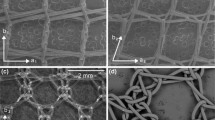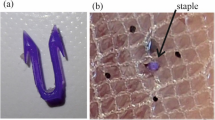Abstract
A medical textile most used for hernia healing and pelvic prolapse organ treatment is surgical mesh. The tensile properties of the mesh play a vital role in the success of treatments based on surgical mesh. Although the probability of hernia recurrence using surgical mesh has dramatically reduced, side effects such as infection and adhesion persist. Most of these complications are related to the surgical mesh structure. Research has continued to improve surgical meshes structures. For this purpose, common net warp-knitted fabrics in surgical mesh production produced with five knit patterns using polypropylene monofilament. Tensile properties of produced meshes were investigated in five different directions (0 ° (course), 30 °, 45 °, 60 °, and 90 ° (wale)), and the role of the mesh structural characteristics on their tensile properties have been analyzed. The results reveal that variations of the studied meshes’ tensile properties in different directions can be justified based on the structural characteristics. Due to the importance of lightness, greater porosity, larger pore size, and more isotropy for surgical mesh, among the considered structures, sandfly is proposed as the best knit-pattern for surgical mesh production.
Similar content being viewed by others
References
V. T. Bartels, “Handbook of Medical Textiles”, 1st ed., Woodhead Publishing Ltd., New Delhi, 2011.
M. Mirjavan, A. Asayesh, and A. A. Asgharian Jeddi, J. Mech. Behav. Biomed. Mater., 66, 77 (2017).
B., Pollard, “Handbook of Clinical Anaesthesia”, 3rd ed., Hodder Arnold, 2011.
S. A. Shah, “Surgical Mesh and Their Fixation”, https://www.slideshare.net/shahzadalamshah/surgical-meshes (Accessed November 21, 2019).
J. Gaoming, M. Xu-hong, and L. Dajun, Fibres Text. East. Eur., 13, 44 (2005).
V. Schumpelick and L. M. Nyhus, “Meshes: Benefits and Risks”, 1st ed., Springer Berlin Heidelberg, New York, 2003.
R. Latifi, “Surgery of Complex Abdominal Wall Defects”, 2st ed., Springer International Publishing AG, New York, 2017.
L. Zogbi in “Biomaterials Applications for Nanomedicine”, 1st ed. (R. Pignatello), Vol. 18, pp.359–382, InTech, Rijeka, 2008.
U. Klinge, J. Park, and B. Klosterhalfen, Pathobiology, 80, 169 (2013).
K. Baylón, P. Rodríguez-Camarillo, A. Elías-Zúñiga, J. Antonio Díaz-Elizondo, R. Gilkerson, and K. Lozano, Membranes, doi: https://doi.org/10.3390/membranes7030047 (2017).
D. Weyhe, W. Cobb, J. Lecuivre, A. Alves, S. Ladet, D. Lomanto, and Y. Bayon, Int. J. Surg., 22, 46 (2015).
Y. Bilsel and I. Abci, Int. J. Surg., 10, 317 (2012).
C. Deeken, M. Abdo, M. Frisella, and B. Matthews, J. Am. Coll. Surg., 212, 68 (2011).
H. P. Dietz, P. Vancaillie, M. Svehla, W. Walsh, A. B. Steensma, and T. G. Vancaillie, Int. Urogynecol. J., 14, 239 (2003).
D. L. Sanders, A. N. Kingsnorth, and B. M. Stephenson, World J. Surg., 37, 737 (2013).
L. Miao, F. Wang, L. Wang, T. Zou, G. Brochu, and R. Guidoin, Materials, 8, 8148 (2015).
M. Badin Dahesh, A. Asayesh, and A. A. Asgharian Jeddi, J. Text. Inst., 111, 1346 (2020).
N. Sanbhal, L. Mial, R. Xu, A. Khatri, and L. Wang, J. Ind. Text., 48, 333 (2018).
S. Todros, J. Invest. Surg., doi: https://doi.org/10.1080/08941939.2020.1849468 (2020).
M. V. Anurov, S. M. Titkova, N. N. Shchegoleva, L. M. Mikhaleva, I. G. Tsitovich, N. V. Galushkina, and A. P. Oettinger, Bull. Exp. Biol. Med., 145, 642 (2008).
Author information
Authors and Affiliations
Corresponding author
Rights and permissions
About this article
Cite this article
Dahesh, M.B., Asayesh, A. & Jeddi, A.A.A. Analysis of the Role of the Structural Characteristics of Surgical Meshes on the Tensile Properties in Different Directions. Fibers Polym 22, 3479–3489 (2021). https://doi.org/10.1007/s12221-021-0348-8
Received:
Revised:
Accepted:
Published:
Issue Date:
DOI: https://doi.org/10.1007/s12221-021-0348-8




